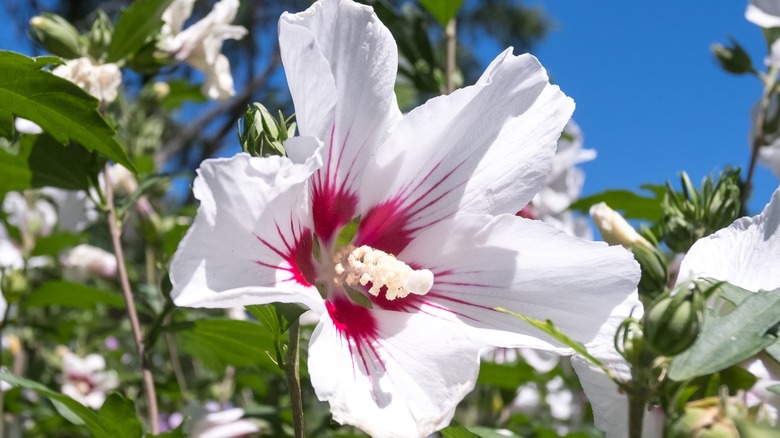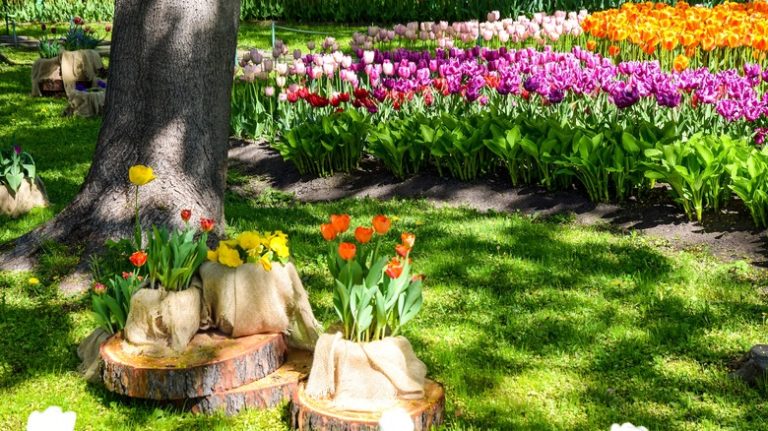Originally collected in the gardens of Syria, Hibiscus syriacus is commonly known as the rose of Sharon or shrub Althea. It is a flowering bush that produces abundant colorful blooms. These blooms come in pinks and reds, as well as lavenders and blues. There are also varieties with white flowers. Because it requires minimal care, per Proven Winners, this easy to grow plant is a favorite among seasoned and beginner gardeners alike. Beyond the showy blooms, which can grow to 3 inches in diameter, the remainder of this hardy plant consists of multiple woody branches with small, toothed medium to dark green leaves. Mature shrubs can reach anywhere from 6 to 10 feet high and 2 to 10 feet wide.
The rose of Sharon is the national flower of South Korea where it is called the mugunghwa, and, according to the South Korean Ministry of the Interior and Safety, it is considered an object of great affection. Kore Limited goes on to call the plant a “symbol of triumph” due to its ability to bounce back. This plant can survive a host of taxing environmental circumstances and will most likely flourish again after experiencing stem breakage or other damage. Nowadays, the flower of the mugunghwa represents the success and prosperity of a globally recognized nation earned through grit and tenacity.
How to use rose of Sharon in garden

A versatile shrub that can grow in much colder zones than its tropical hibiscus cousin, the rose of Sharon makes a bright and attractive addition to many gardens as a stand alone or in a foundation planting with other shrubs. Small specimens can be grown in containers, but Proven Winners suggests the plants be grown in the ground. This makes them an ideal choice for landscaping borders. When planted in this way they can be sheared into hedges. Other options include training the branches along a fence or trellis, or growing a shrub against a wall.
Shrub hibiscus tend to grow taller than they do wide. As such, different varieties can be used to make a multicolored ornamental privacy screen. When planted alone, the height of a single bush combined with its abundant pops of color create an appealing focal point. The nectar of their blossoms also attracts hummingbirds, butterflies, and other pollinators, adding to the beauty and serenity of any yard.
How to grow rose of Sharon
Rose of Sharon plants like to spread. According to Plant Care Today, each bush requires 6 feet of aboveground space around it. Once you’ve found a spot that receives at least 6 hours of sunlight a day, you’ll want to gather your hand trowel and shovel, and get ready to dig.
This large hole will need to be at least as deep as the original pot the plant came in, and two to three times wider. When you’re ready to move the plant into the ground, brace the base of the trunk with one hand. Then turn it over and gently tap the bottom of the grow pot with your other hand to loosen the root ball and make it easy to remove.
Gently massage the root ball. Loosening the roots gives them a better chance of spreading evenly into the ground. If the roots are knotted, trim them for added benefit. If not, simply place the root ball in the middle of your pre-dug hole and surround it with an outdoor garden soil mix. Press lightly to ensure the base is steady and refill the rest of the hole with the native soil you removed. All that’s left to do now is give your plant some water with a garden hose. After planting, you may add an optional layer of mulch to retain moisture and curb weeds. In the next section we’ll discuss care and propagation.
How to care for rose of Sharon
sang woon/Shutterstock
One reason these shrubs are so popular in urban areas is their tolerance to heat, humidity, and drought. The Spruce suggests regular watering and fertilizer for younger plants, but once they are on their way, mature shrubs require little attention. In fact, fertilizer is only recommended for mature plants when they must be planted in particularly nutrient deficient soil.
Provided it is receiving adequate sunlight, your rose of Sharon will likely do well on its own. These plants can even grow in partial shade, but this will minimize the quantity of blooms. Additionally, rose of Sharon doesn’t like extreme temperatures, extreme dryness, and waterlogged soil. Gardening Know How says you will know your plant is in trouble if its leaves turn bright yellow. From there you can deduce the problem and adjust accordingly. Furthermore, pruning is generally unnecessary. However, if you wish to do so, complete pruning by late winter or early spring before buds develop.
As for propagation, rose of Sharon plants naturally propagate through reseeding. Therefore, you may see new growth in the area around your original planting. At times, this can be seen as a nuisance, but if you have the space and welcome more shrubs, it could mean even more gorgeous flowers in your garden. Finally, an inexpensive way to purposefully create new plants is via stem cuttings. While this may seem intimidating, The Spruce provides an in-depth, step-by-step guide to stem cutting propagation that anyone can follow.
Rose of Sharon varieties
Nahhana/Shutterstock
It is important to note that though they share the name hibiscus, shrub rose of Sharon plants differ from tropical and perennial hibiscus. To begin with, they thrive in lower temperatures and tend to be hardier and more adaptable, even while maintaining the sought after “Hawaiian” look.
Unlike tropical hibiscus, rose of Sharon do not bloom in yellow or orange. Of the three forms of hibiscus, rose of Sharon has the smallest blossoms. Flowers grow to be 2 to 3 inches in diameter as opposed to tropical blooms, which are 4 to 6 inches, and perennial, the largest blooms can be up to 9 inches. Although they do produce smaller flowers, these mighty plants make up for it by providing a greater abundance of blooms overall.
Among the many variants found within the Hibiscus syriacus species, Gardening Chores cites the purple and red heart varieties as some of the most beautiful. Their color makeup creates an eye-catching contrast with white petals against purple or red centers. Oiseau Bleau (pictured above) is another popular variant because of its striping pattern that makes the dark purple base look like rays emanating from the center. Ultimately, there are dozens of beautiful options to choose from. Whichever color you go with in the end, you are bound to adore the burst of brightness you receive when you add a rose of Sharon to your garden.
Is rose of Sharon toxic?
Noemi S Rivera/Shutterstock
While considered non-toxic to humans, rose of Sharon is a type of hibiscus that can be poisonous to dogs, cats, and horses. According to the pet care website Wag!, dogs may like the taste of their flowers and leaves, which can prompt them to ingest large amounts. Care must be taken to keep your furry family members safe.
There is good news when it comes to the toxicity of these plants: The prognosis for poisoning is generally good and symptoms tend to be mild. Vomiting and diarrhea are the most common occurrences and neither should last more than 12 to 24 hours. Other possible symptoms include excessive drooling and loss of appetite.
Because these symptoms mirror those of more serious toxins, it is vital to be sure which plant your dog consumed. If you are uncertain, or if there is blood present in any of your pet’s vomit or diarrhea, immediately contact a veterinarian for professional advice and care. When necessary they will perform tests and procedures to ensure your pet’s health and safety.
How to repot rose of Sharon
Ludmila Ivashchenko/Shutterstock
These large shrubs are known to flourish when planted in the ground, but don’t let that stop you if you’re short on yard space. A thriving potted rose of Sharon is possible with some additional attention and care. For avid gardeners who enjoy regular plant tending, this should be no problem at all. As per The Spruce, sure signs for when a plant needs to be re-potted are when it becomes top heavy or when the roots are sticking out of its drainage holes. Roses of Sharon are bulky and sometimes heavy, so before you start, make sure you have any necessary helping hands nearby, as well as your supplies.
Your new pot should be one size up from your existing pot. Don’t forget to check that it has adequate drainage holes. For this simple task, you won’t need more than a hand trowel and optional gardening gloves along with potting soil and fertilizer granules.
The steps to re-potting any plant are similar to those of moving it from its grow pot to a permanent home in the ground. First add the potting soil to your new container until it is 1/3 full. Then release the plant from its original pot, gently loosening the roots. Trim only if needed. Place the root ball in the new pot and surround it with more soil mix up to the top. Before watering, it’s a good idea to add a carefully measured scoop of fertilizer granules.


